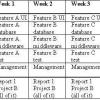Process
Articles
|
Interface or Interfere? One of the Holy Grails of automated quality toolsets is a fully integrated suite that seamlessly tracks the process all the way from requirements to test cases and on through to defect tracking. This fully integrated suite makes for a great marketing pitch and sexy slideware, but in Linda Hayes' experience its functionality usually stops there. The leap from theory to practice seems to fall short, and it makes her wonder whether the concept of a fully integrated suite is fundamentally flawed or if it's just the implementation that needs attention. In this column, she begins her investigation by studying two test cases to decide whether these experiences are anomalies or the rule. |
||
|
Issue Priority and Severity There are several topics that can trigger near religious fervor in software developers--languages, indentation, and comments come immediately to mind. One of Peter Clark's personal favorites is the relationship of issue priority to issue severity in defect tracking systems. Just what the heck do all those levels mean, anyway? In this week's column, Peter describes a solution that his company devised to clearly define the characteristics of severity and priority and help them better understand how the two work together. |
Peter Clark
December 30, 2005 |
|
 |
Test-based Project Progress Reporting Deliverable-oriented project management and test-driven development can be combined to provide an objective and easily understandable way of measuring project progress for the client, team members, and management. In this article, John Ferguson Smart presents a case study of how this approach was made to work. |
John Ferguson Smart
December 27, 2005 |
|
Release Management—Making It Lean and Agile Release management is an awesome responsibility that plays a vital role in the success of a software development project. Releasing is often considered to be an activity that happens near the end of the process—a necessary evil, perhaps, but no more. |
||
|
Building a Configuration Management (CM) Capability for Test
As more test items exist, there is a tendency for them to evolve due to the changes to requirements and code and, therefore, must be managed effectively. When there are an increasing number of test items, this increases the risk of failing to accurately track all test items, particularly when this is done manually. This is where configuration management (CM) can help.
|
||
 |
How Much Work Can You Do—Developing and Managing Your Project Portfolio Knowing how much work your group can accomplish—and how much it takes to complete that work—is critical to your success as a manager. Johanna Rothman explains how to ascertain your team's potential and how to use that information to define and manage your project portfolio so it doesn't manage you. |
|
|
A Bug Begets a Bug In his April 2005 column, "After the Bug Report," Danny R. Faught suggested that when you're testing a bug fix, you should also look for additional bugs. This week, he expands on that idea, showing you how one bug report can multiply into many more bugs. |
||
 |
So You Have a New Job Assignment Every change involves endings, and endings mean loss. Even the best changes mean some things will end; things that are like warm, fuzzy blankets will be taken from us. But as one thing ends, a new one begins. In this week's column, Lee Copeland assures us that new beginnings involve new understandings, new values, new attitudes, and, most importantly, a new identity for you. |
|
 |
Whipped Cream on Top of the Sundae Service and a good variety of features are key in developing relationships with the customer. We always want to satisfy our customers. But if we sometimes exceed their expectations, overly satisfied customers will more than likely spread the news about our service or product--we've added whipped cream, and maybe even a cherry, on top of their ice cream. In this week's column, Mike Cohn explains how he measures customer satisfaction using Kano analysis, which categorizes the features customers look for into baseline, linear, and exciter features. Doing so will help us identify which features will delight our end users, and help us surpass the level of simple satisfaction. |
|
 |
Free Time is Not Free Unpaid overtime has negative personal and business consequences. Although regarded as free time by many organizations, there is a true business cost to not estimating or counting overtime hours, whether paid or not. Ed Weller presents the argument that those who do not count free time in their planning and tracking will make poor decisions and often invest in the wrong projects. |
Pages
Recommended Web Seminars
| May 23 | How Generative AI Boosts Speed and Quality in Software Testing |
| On Demand | Building Confidence in Your Automation |
| On Demand | Leveraging Open Source Tools for DevSecOps |
| On Demand | Five Reasons Why Agile Isn't Working |
| On Demand | Building a Stellar Team |










